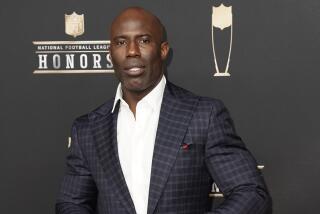Another reason to avoid United Airlines: Its dopey boarding procedure

- Share via
United Airlines has long been the drunk uncle of American carriers -- tolerated at the table when there’s no alternative, avoided whenever possible. In the latest airline quality rating survey released in April by researchers at Purdue, United came in worst, marked down for on-time takeoffs, baggage handling and other consumer complaints. Only three weeks ago, federal regulators slapped the airline with their largest fine ever--$1.1 million for leaving passengers on 13 flights stranded on the tarmac last summer during thunderstorms in Chicago.
Having just finished a vacation featuring a round trip on United, I can report another annoyance: its procedure for boarding aircraft. Instead of boarding back-to-front, like most carriers, or randomly, like Southwest, United boards window-first. It’s a system that only a mad scientist could love.
This boarding procedure is unusual among American carriers, but it isn’t unique. There’s even a name for it -- “WilMA,” for window-middle-aisle. (No one seems to know where the “IL” comes from.) Some air travel specialists, including those on United’s payroll, contend that it’s actually the fastest way to board passengers on an airliner.
Given the cost of keeping a plane at the gate while passengers shuffle on and off, you won’t be surprised to learn that extensive literature exists on boarding practices and procedures.
Yet all these studies seem to be performed under laboratory conditions. And it’s true that WilMA tends to rank high, in the lab. That’s important, because it’s in the real world that WilMA, among other systems, breaks down. It’s also the real world that prevents all airlines from instituting the one policy change that would produce the fastest boarding of all; more on that in a moment.
You can see some technical logic for WilMA. Boarding delays come from two sources -- aisle blockages from passengers loading their bags in the overhead bins, and blockages from seated passengers getting up to let others squeeze by into middle and window seats. The common back-to-front system aims to keep the first class of bottlenecks out of the way of most passengers. WilMA is designed to minimize the latter.
Accordingly, United divides passengers into five boarding groups. The first two are for business- and first-class passengers and elite frequent fliers. The last three are, in order, window seats, middle seats, and aisles. My wife and I both prefer aisle seats; when we travel together we try to snag seats across from one another in the same row. So this time we ended up in Group 5, the last to board.
That’s where we discovered how the real world interferes. For one thing, WilMA breaks up traveling parties. Families and friends flying together tend to reserve in rows; WilMA sows confusion by keeping them from boarding together. That’s not a huge problem because ground crews will probably let families board together. But it’s just the first way that the airline subverts its own master plan.
United, like all airlines, awards preferential boarding to high-fare passengers and many frequent fliers. Every step in that direction undermines WilMA (as it does every boarding system). What’s worse, however, is that WilMA increases the chances that the bins over a given row will all be filled by the time an aisle passenger arrives, especially on a full flight. Our ground crew and flight attendants knew this, and began warning us while we were still lined up at the gate to stow our bags in the first open bin we found.
As a result, we stowed our roll-ons over Row 10, which was unoccupied when we were still making our way back to Row 26. A few minutes later, the Row 10 passengers showed up -- and the game began of finding room for their bags. Did this cause delay? Of course it did -- on boarding and again on disembarking, when they had to wait for the plane to clear out before they could retrieve their luggage.
In other words, United’s own crews screwed up its system.
Experts and experienced passengers won’t stop debating the best way to board a flight any time soon; a couple of years ago an actual rocket scientist, Jason Steffens of Fermilab, cooked up a staggered system that he claimed beat all the others in speed. But that came at the cost of imposing a highly complex arrangement of passengers lining up at the gate, so it’s unsurprising that it hasn’t been embraced by the industry.
Judging by actual experience, the best system appears to be Southwest’s. Passengers line up for boarding in the order they check in, though you can buy yourself to the front of the line. Once you’re aboard, however, seats are unassigned, so passengers find their own methods to keep out of each other’s way. I’ve witnessed Southwest load an entire plane in 15 minutes -- the airline says its average is about 25 -- but United set aside a full 45 minutes to board each of our flights.
Still, if the airlines really want to cut down on boarding bottlenecks, obviously the best way to do so is to cut down on carry-on bags. Here’s another way they’ve undermined their own interests -- charging fees for checked baggage has simply encouraged more people to carry on, and to stuff their roll-on bags with more stuff than they can properly hold.
But the quest for checked-bag fees evidently trumps the need for quick boarding. United would have charged us $25 for our first checked bags, so we carried-on. Did it take longer to load our flight? Tough. The airline had no one to blame but itself.
What’s your solution to boarding a plane quickly?
More to Read
Sign up for The Wild
We’ll help you find the best places to hike, bike and run, as well as the perfect silent spots for meditation and yoga.
You may occasionally receive promotional content from the Los Angeles Times.







